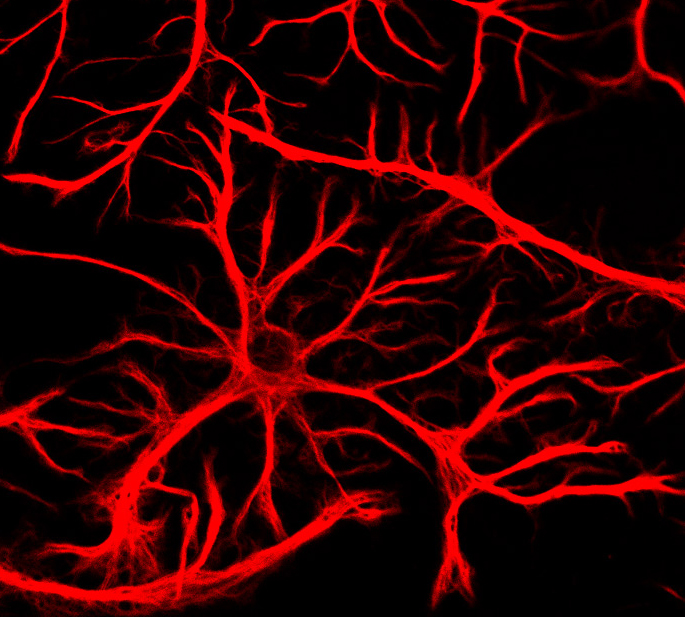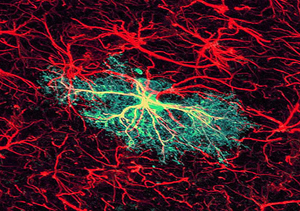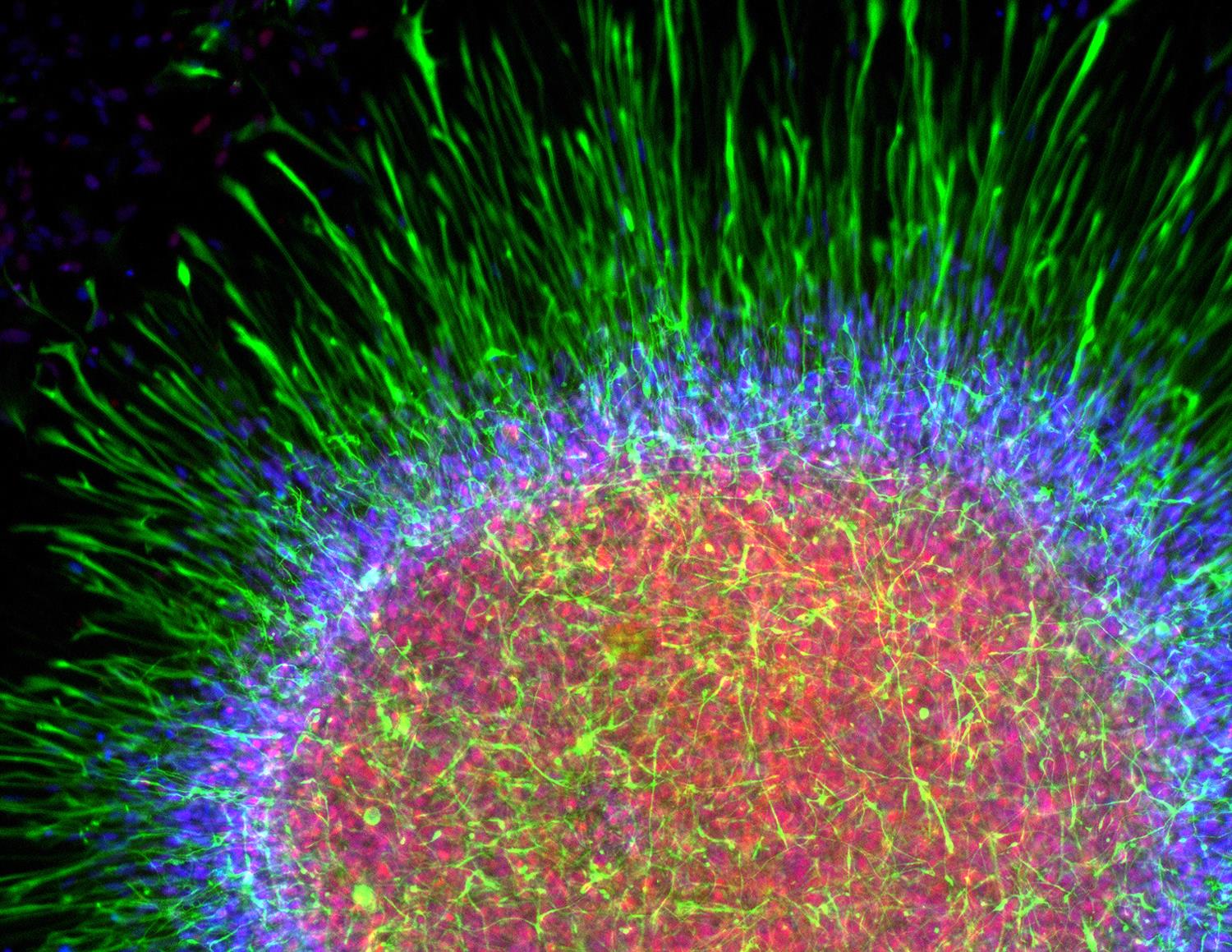
A starry knight? The introduction of healthy astrocytes in people with ALS may help keep existing motor neurons 'alive' by reducing levels of potentially toxic substances including glutamate. Image: Jonathan Cohen PhD, National Institute of Child Health.
More than 10 stem cell strategies are being developed for ALS across the globe. One of these potential treatments, known as astrocyte replacement, is approaching the clinic. The strategy aims to protect motor neurons by introducing healthy astrocytes in people with ALS in hopes to detoxify the nervous system.
But according to recent preclinical studies, this approach may be limited because astrocytes may be a key player in ALS in only certain forms of the disease.
Now, a US team led by Nationwide Children’s Hospital’s Brian Kaspar PhD reports that astrocytes may contribute to motor neuron loss in people with C9ORF72-linked ALS.
The results suggest that strategies targeting astrocytes might benefit many people with ALS – including those with the most common form of the disease identified to date.
Nationwide Children’s Hospital neuroscientist Katherine Meyer PhD presented the results last week at the 2013 meeting of the Society of Neuroscience in San Diego.
Clinicians first turned to stem cells in the late 1990s in hopes to treat ALS. The strategy aimed to help people with ALS keep moving by replacing motor neurons destroyed by the disease.
But this approach turned out to be too tricky to do. Motor neurons must plug into the central nervous system. And, their axons need to be extended nearly 3 feet to reach the muscles.

Appetite for destruction? Astrocytes (green) may contribute to ALS in part by failing to regulate levels of glutamate in motor neurons. Image: Hajime Hirase PhD, RIKEN Brain Science Institute.
This stem-cell based procedure could take 2-3 years by some estimates to potentially take effect– too late for many people with the disease.
In the mid 2000s, researchers turned to astrocytes as a more feasible approach to treat the disease. The potential stem cell treatment, known as astrocyte replacement, involves injection of astrocyte precursors directly into the spinal cord.
The strategy aims to protect existing motor neurons in people with ALS by restoring the balance of key neuronal substances including glutamate in the brain and spinal cord.
One approach, known as Q cells, according to preclinical studies led by Johns Hopkins University School of Medicine's Nicholas Maragakis MD appears to delay onset and extend survival of the G93A SOD1 mouse model of ALS.
Astrocyte replacement is now at the IND-enabling stage - the final step before entering the clinic. At least three strategies are being developed. An IND could be filed as early as February 2014 according to Cedar Sinai's Clive Svendsen PhD.
But which people might benefit from astrocyte replacement remains an open question.
Astrocytes regenerated from skin cells from people with SOD1-linked ALS appear to contribute to motor neuron loss. But according to studies led by Johns Hopkins University School of Medicine’s Nicholas Maragakis MD and University of Edinburgh’s Siddharthan Chandran PhD, motor neurons appear to emerge unscathed when co-cultured with astrocytes harboring mutations in TDP-43, a protein mislocalized in most people with the disease.

Replacement, Ltd? Astrocytes harboring mutations in TDP-43 appear to leave motor neurons untouched - at least in mice. But according to preliminary co-culture results from Nationwide Children’s Hospital’s Katherine Meyer PhD, these astrocytes may contribute to motor neuron loss – at least under certain conditions. Image: Robert Krencik, University of Wisconsin.
Now, researchers from Nationwide Children’s Hospital report that astrocytes in people with C9Orf72-linked ALS may be a key player in the disease.
The “induced” astrocytes, directly converted from skin cells from three people with C9Orf72-linked ALS, reduced survival of mouse motor neurons by at least 50%.
The preliminary co-culture findings come at the heels of previous studies from Amanda-Haidet Phillips PhD, now at Johns Hopkins University School of Medicine, and Columbia University’s Virginia Le Verche PhD which suggest that astrocytes may contribute to motor neuron loss in certain forms of sporadic ALS.
Together, the results suggest that astrocytes may be a key player in ALS in many people with the disease. And, potential treatments directed at astrocytes may be of benefit to them.
Clinicians hope to launch phase I studies of astrocyte replacement sometime next year.
***
To learn more about astrocyte replacement, tune into our podcast with Johns Hopkins University School of Medicine’s Nicholas Maragakis MD, A new player in the stem cell Q? To find out about other stem cell strategies being developed the disease, check out our report from the 2013 meeting of the International Society of Stem Cell Research, ALS, Stem to Stern.
References
Haidet-Phillips, A.M., Gross, S.K., Williams, T., Tuteja, A., Sherman, A., Ko, M., Jeong, Y.H., Wong, P.C. and Maragakis NJ (2013) Altered astrocytic expression of TDP-43 does not influence motor neuron survival. Experimental Neurology doi: 10.1016/j.expneurol.2013.10.004. Abstract | Full Text (Subscription Required)
Serio, A. et al. (2013) Astrocyte pathology and the absence of non-cell autonomy in an induced pluripotent stem cell model of TDP-43 proteinopathy. Proceedings of the National Academy of Sciences 110(12): 4697-4702. Abstract | Full Text
Haidet-Phillips, A.M. et al. (2011) Astrocytes from familial and sporadic ALS patients are toxic to motor neurons. Nature Biotechnology,29(9), 824-8. Abstract | Full Text (Subscription Required)
Lepore, A.C., Rauck, B., Dejea, C., Pardo, A.C., Rao, M.S., Rothstein, J.D., and Maragakis, N.J. (2008). Focal transplantation-based astrocyte replacement is neuroprotective in a model of motor neuron disease. Nature Neuroscience, 11(11), 1294-1301. Abstract | Full Text
Yamanaka, K., Chun, S.J., Boillee, S., Fujimori-Tonou, N., Yamashita, H., Gutmann, D.H., Takahashi, R., Misawa, H. and Cleveland DW. (2008) Astrocytes as determinants of disease progression in inherited amyotrophic lateral sclerosis. Nature Neuroscience 11(3), 251-253. Abstract | Full Text
Further Reading
Robberecht, W. and Philips, T. (2013) The changing scene of amyotrophic lateral sclerosis. Nature Reviews Neuroscience 14(4), 248-264. Abstract | Full Text (Subscription Required)
Papadeas, S.T. and Maragakis, N.J. (2009) Advances in stem cell research for Amyotrophic Lateral Sclerosis. Current Opinion in Biotechnology 20(5), 545-551. Abstract | Full Text (Subscription Required)